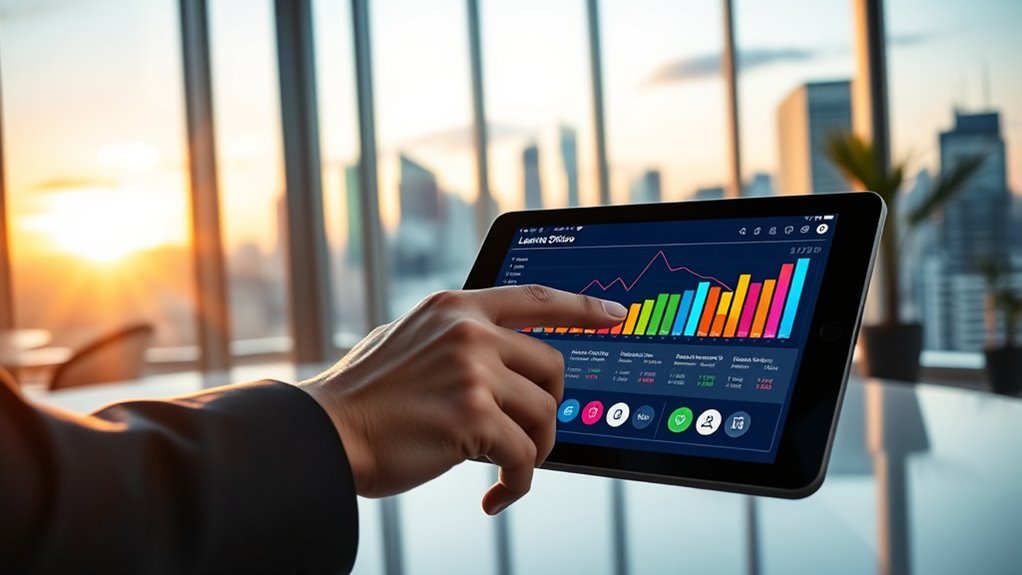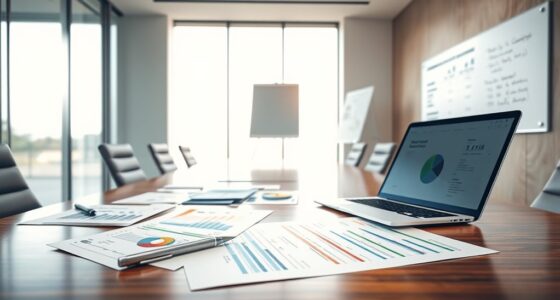Leasing your equipment in 2025 can rescue your monthly cash flow by spreading costs over time, helping you avoid large upfront payments. It preserves your cash reserves, making it easier to manage day-to-day expenses and invest in growth opportunities. Plus, flexible lease terms can be adjusted to fit your revenue cycles, keeping payments predictable. Keep exploring to discover how leasing can keep your business financially healthy and ready for the future.
Key Takeaways
- Leasing preserves cash liquidity by avoiding large upfront equipment costs and spreading payments over time.
- Flexible lease terms can be tailored to align with revenue cycles, improving cash flow predictability.
- Leasing reduces unexpected repair and upgrade expenses, stabilizing monthly cash outflows.
- It converts capital expenses into manageable operating expenses, freeing cash for other growth initiatives.
- Leasing enhances financial stability and borrowing capacity, supporting strategic investments in 2025.

As we look ahead to 2025, understanding how leasing impacts cash flow is more important than ever. In today’s fast-changing business environment, managing your cash flow effectively can determine your company’s success or failure. Leasing offers a strategic way to keep your cash liquid, especially when it comes to acquiring essential equipment. Instead of large upfront costs that strain your reserves, equipment financing through leasing spreads payments over time, helping you preserve capital for other operational needs or growth opportunities. This approach allows you to access the latest technology or machinery without depleting your cash reserves, giving you a competitive edge.
Leasing helps preserve cash flow and access the latest equipment without large upfront costs.
One key benefit of leasing is the flexibility it provides during lease negotiations. When you negotiate a lease, you can tailor the terms to fit your financial situation, whether that means adjusting payment schedules, including maintenance services, or extending the lease duration. This flexibility helps you align your payments with your revenue cycles, making cash flow more predictable and manageable. Effective lease negotiation can also reduce upfront costs, lower monthly payments, and improve your overall financial planning. It’s essential to approach lease negotiations with a clear understanding of your business needs and a focus on minimizing long-term expenses, which can profoundly impact your cash flow stability.
Leasing can also shield your business from unexpected expenses that often come with equipment ownership, such as repairs or obsolescence. When you opt for equipment financing through leasing, many agreements include maintenance or upgrade options, reducing the risk of sudden capital drains. This predictability can be a game-changer, especially in 2025 when supply chain disruptions and technological advances can quickly make equipment outdated. Instead of large, unpredictable capital expenditures, you enjoy fixed monthly payments that help you plan your budget with confidence. Additionally, understanding the importance of affiliate disclosures and transparent financial relationships helps ensure your leasing decisions are made responsibly and ethically.
Furthermore, leasing can improve your balance sheet by converting what would be capital expenses into operating expenses, which are often easier to manage from an accounting perspective. This can improve key financial ratios and make your business more attractive to lenders or investors. Plus, leasing allows you to keep your borrowing capacity intact for other strategic investments, such as expanding your operations or funding marketing campaigns.
Frequently Asked Questions
How Does Leasing Impact My Credit Score?
Leasing can affect your credit score by influencing credit impact and score factors. When you lease, your payment history, which is a key score factor, shows up on your credit report. Consistent payments can boost your score, while missed or late payments may hurt it. Additionally, some leases are reported as loans, impacting your debt-to-income ratio. Overall, responsible leasing can improve your credit, but missed payments can have negative effects.
Are Lease Agreements Flexible for Changing Business Needs?
You might think lease agreements are rigid, but many are surprisingly flexible. They often include options for lease renewal, allowing you to extend or modify terms as your business evolves. Plus, leases can facilitate equipment upgrades, helping you stay current without large upfront costs. This flexibility means you can adapt to changing business needs, ensuring you’re not locked into outdated terms or equipment, ultimately supporting your growth and agility.
What Are Hidden Costs Associated With Leasing?
When you consider leasing, watch out for hidden costs like unexpected charges after the lease term ends. You might face costs if the residual value of the asset is lower than expected, or if you exceed mileage limits or wear and tear allowances. Always clarify these details upfront to avoid surprises, and understand how the lease term impacts your overall expenses and potential costs at the end of the lease.
Can Leasing Help With Tax Deductions in 2025?
Think of leasing benefits as planting seeds for future tax advantages. When you lease, you often get to deduct payments as operational expenses, which can lower your taxable income. This means you can enjoy immediate tax benefits, helping your cash flow stay healthy. Leasing can be a strategic move, turning your equipment expenses into a tax-saving tool, making it easier to manage your finances in 2025.
How Does Leasing Compare to Buying in Long-Term Cash Flow?
When comparing leasing to buying, you’ll find leasing often offers a better cost comparison initially, with lower monthly payments and less upfront cash needed. Over the long term, ownership benefits like asset value and eventual full control may favor buying. However, leasing helps preserve cash flow, reduces maintenance costs, and provides flexibility, making it a smart choice for steady cash flow management in 2025.
Conclusion
Leasing could be your secret weapon to improve cash flow in 2025. Did you know that businesses that lease equipment save an average of 20% on upfront costs compared to buying outright? By choosing leasing, you keep more cash liquid for other opportunities and expenses. So, if you want to stay flexible and financially healthy in the coming year, consider leasing—it might just be the move that keeps your cash flow steady and your business thriving.










